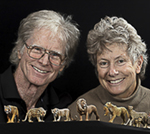Jaguars of Brazil's Pantanal
Photo Safari and Tour Brochure
2025 Photo Tour Dates
Dates: July 21-31, 2025
Price: $ 10345
August 4-14, 2025
Price: $ 10345
August 15-25, 2025
Price: $ 10345
limited Single Supplements available
Check out our Pantanal Portfolio
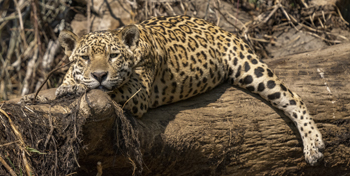
Nine facts to consider before you read on:
1. We have been leading photo tours to the Pantanal for 15 years,
and the first
to offer trips specifically for jaguars.
2. We limit our trips to only two boats,
each personally guided by Joe and Mary Ann.
You are always accompanied by one of us.
3. We never substitute inexperienced guides or leaders.
4. Each boat is limited to four photographer/participants.
5.We stay at three diverse photo locations
to maximize your photography of all wildlife species.
6. In Jaguar country we use an on-site Flotel that minimizes
or eliminates long boat commutes to photo locations.
7. We are not 'jaguar centrix.'
Although you're likely to see 15-25 jaguars, your portfolio
will include many species of mammals, reptiles, and birds.
8. Unparalled pre-trip information and preparation,
and detailed post-trip follow-up information on your trip.
9.
Most importantly we know the wildlife, what is interesting behaviour that is worth waiting for. You are with experienced Naturalists when you are with us.
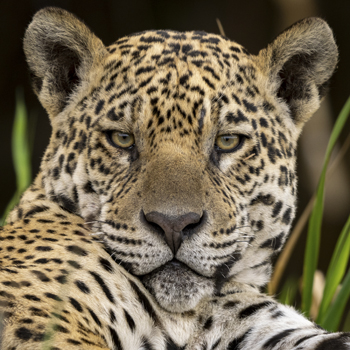
What you can expect from us
The most productive photo tour possible.
Accurate, informative natural history information.
Professional help in your photography - compositions, positioning, exposure.
Our Interpretation and Expertise
Informal Lunch and Dinner Discussions on What You Saw and what it means
Driver-Guide Tip is included in the tour price.
FREE ebook
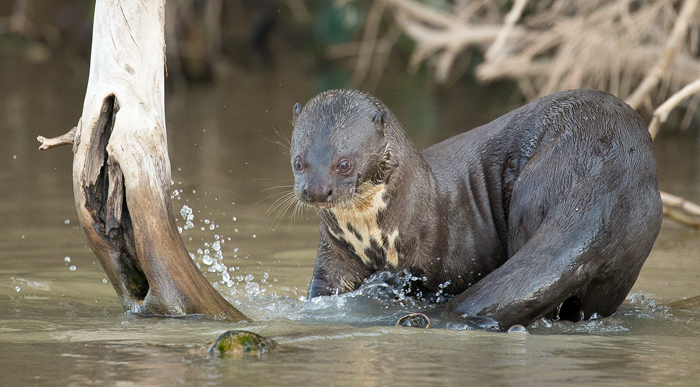
Our Photo Safari
We'll be visiting three locations: Jaguarland - the river system where we'll see the most jaguars, and two land-based lodges which will maximize our opportunities for photographing a diversity of wildlife.
The Flotel (Southwild Jaguar Flotel, Brazil - Natural World Safaris) is the choice of most professional photographers. There are spacious suites as well as cabins (we use a cabin), with great food and the fastest access to jaguar country. Some tours stay at a busy hotel in the nearest small town, requiring at least a 15-20 minute commute four times a day. Your room and our meals on the flotel are just seconds away, not requiring long walks to your room or dining area. Check the link above -- there's been very misleading information presented on this. Photographers that have used both unanimously prefer the Flotel.
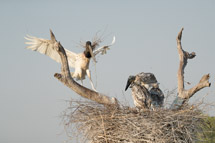
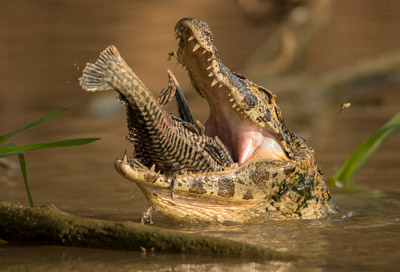
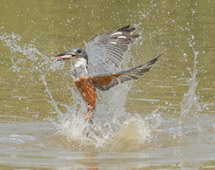
At the lodges we'll be photographing a variety of wildlife that usually includes brown capuchin monkeys, Jabiru storks, toco toucans, parakeets, caimans, howler monkeys, great potoos, and a variety of other birds, including kingfishers, hawks, herons, and other water birds.
We'll be photographing some of these species from land - on the grounds of the lodges or from a special safari vehicle, while some species may be filmed from boats. At one lodge there is a tower for nesting Jabiru Storks from an eye-level perspective.
Between these three locations one could photograph at least nine species of mammals and at least 60 species of birds, and closer to 75 to 100 species of birds if you concentrated on doing so. Additionally, there are toads and treefrogs, and some lizards and, of course, large caimans. As part of the tour, you will receive my ebooks on the 'Birds of the Pantanal' and 'Jaguars and the Wildlife of the Pantanal.'
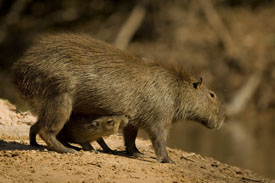
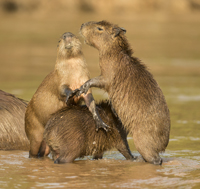
Cabybaras are the world's largest rodent, a giant deer-like beaver, and are common, and favorite jaguar foods.
Most of the jaguar photography will be from our 10-passenger boats where we'll have only four photographer/participants per boat, each with their own row of seats giving everyone plenty of room. We use only two boats, in radio contact, and our participants are always accompanied by either Mary or Joe, with our wonderful in-country guide always with us. You won't be in an unaccompanied boat- you'll have Joe or Mary and our in-country guide with you on every excursion, for spotting wildlife, photo instruction, and help.
Special Ocelot Photography!
Participants will have at least one evening for possible Ocelot photography at a special bait station. One or more Ocelots regularly visit the station - 60% of the time on average, and we usually have the opportunity to try this a second time if we're not successful.

TRIP DETAILS AND PRICING
The Photo Tour begins and ends in Cuiabá, Matto Grosso, Brazil. From Cuiabá we'll travel by land into the Pantanal to our various destinations, until we board our boats for our stay at the Flotel where we will be based in true jaguar country.
In-country road transportation with the group, all meals, and lodging (double occupancy) is included. If you miss the flight to Cuiabá with the group (this flight is not included but Mary tells you what flight to make), our Brazilian tour company will provide the land transportation to our location in the Pantanal, however, you are responsible for that transportation cost, as well as any lodging or food costs incurred. We recommend participants arriving in Sao Paulo early in order to make the connecting flight to Cuiaba.
Limited single supplements are available at all locations for an additional cost.
Tips for the boatmen and Brazilian guide are included, however participants usually add a little extra as a gratuity, although this is optional.
We rotate everyone through our two boats so that everyone has the benefit of our wonderful Brazilian guide (one of the best I've had anywhere in the world) and with Mary and with Joe, and with our two veteran boatmen.
The Photo Tour/Safari is limited to 8 participants. Please contact our office immediately if you are interested.
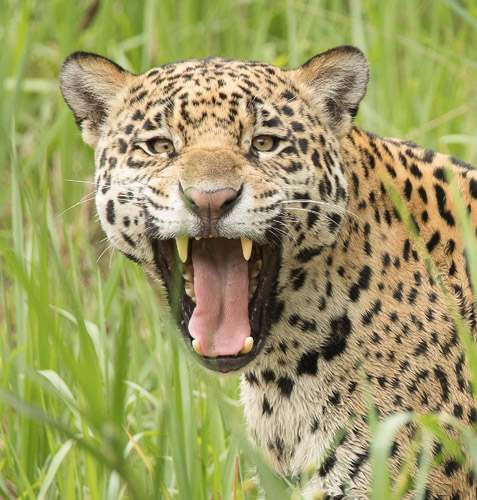
For over 35 years we've been offering high intensity photo workshops at our home at Hoot Hollow, and have led photo tours and safaris around the world.
For more information, check out:
Facebook
Flickr
Instagram
YouTube Channel
Join us on Facebook at: Follow Hoot Hollow
Office Phone: (717) 543-6423
Email us at info@hoothollow.com
Mary and Joe are proud to endorse the Photo Retailer that has
done the absolute most in supporting nature photography in all
its facets ---

Check out the Monthly Specials
from Hunt's
Jaguars of Brazil's Pantanal
Photo Safari and Tour Brochure
2025 Photo Tour Dates
Dates: July 21-31, 2025
Price: $ 10345
August 4-14, 2025
Price: $ 10345
August 15-25, 2025
Price: $ 10345
limited Single Supplements available
Check out our Pantanal Portfolio

Nine facts to consider before you read on:
1. We have been leading photo tours to the Pantanal for 15 years,
and the first
to offer trips specifically for jaguars.
2. We limit our trips to only two boats,
each personally guided by Joe and Mary Ann.
You are always accompanied by one of us.
3. We never substitute inexperienced guides or leaders.
4. Each boat is limited to four photographer/participants.
5.We stay at three diverse photo locations
to maximize your photography of all wildlife species.
6. In Jaguar country we use an on-site Flotel that minimizes
or eliminates long boat commutes to photo locations.
7. We are not 'jaguar centrix.'
Although you're likely to see 15-25 jaguars, your portfolio
will include many species of mammals, reptiles, and birds.
8. Unparalled pre-trip information and preparation,
and detailed post-trip follow-up information on your trip.
9.
Most importantly we know the wildlife, what is interesting behaviour that is worth waiting for. You are with experienced Naturalists when you are with us.

What you can expect from us
The most productive photo tour possible.
Accurate, informative natural history information.
Professional help in your photography - compositions, positioning, exposure.
Our Interpretation and Expertise
Informal Lunch and Dinner Discussions on What You Saw and what it means
Driver-Guide Tip is included in the tour price.
FREE ebook

Our Photo Safari
We'll be visiting three locations: Jaguarland - the river system where we'll see the most jaguars, and two land-based lodges which will maximize our opportunities for photographing a diversity of wildlife.
The Flotel (Southwild Jaguar Flotel, Brazil - Natural World Safaris) is the choice of most professional photographers. There are spacious suites as well as cabins (we use a cabin), with great food and the fastest access to jaguar country. Some tours stay at a busy hotel in the nearest small town, requiring at least a 15-20 minute commute four times a day. Your room and our meals on the flotel are just seconds away, not requiring long walks to your room or dining area. Check the link above -- there's been very misleading information presented on this. Photographers that have used both unanimously prefer the Flotel.



At the lodges we'll be photographing a variety of wildlife that usually includes brown capuchin monkeys, Jabiru storks, toco toucans, parakeets, caimans, howler monkeys, great potoos, and a variety of other birds, including kingfishers, hawks, herons, and other water birds.
We'll be photographing some of these species from land - on the grounds of the lodges or from a special safari vehicle, while some species may be filmed from boats. At one lodge there is a tower for nesting Jabiru Storks from an eye-level perspective.
Between these three locations one could photograph at least nine species of mammals and at least 60 species of birds, and closer to 75 to 100 species of birds if you concentrated on doing so. Additionally, there are toads and treefrogs, and some lizards and, of course, large caimans. As part of the tour, you will receive my ebooks on the 'Birds of the Pantanal' and 'Jaguars and the Wildlife of the Pantanal.'


Cabybaras are the world's largest rodent, a giant deer-like beaver, and are common, and favorite jaguar foods.
Most of the jaguar photography will be from our 10-passenger boats where we'll have only four photographer/participants per boat, each with their own row of seats giving everyone plenty of room. We use only two boats, in radio contact, and our participants are always accompanied by either Mary or Joe, with our wonderful in-country guide always with us. You won't be in an unaccompanied boat- you'll have Joe or Mary and our in-country guide with you on every excursion, for spotting wildlife, photo instruction, and help.
Special Ocelot Photography!
Participants will have at least one evening for possible Ocelot photography at a special bait station. One or more Ocelots regularly visit the station - 60% of the time on average, and we usually have the opportunity to try this a second time if we're not successful.

TRIP DETAILS AND PRICING
The Photo Tour begins and ends in Cuiabá, Matto Grosso, Brazil. From Cuiabá we'll travel by land into the Pantanal to our various destinations, until we board our boats for our stay at the Flotel where we will be based in true jaguar country.
In-country road transportation with the group, all meals, and lodging (double occupancy) is included. If you miss the flight to Cuiabá with the group (this flight is not included but Mary tells you what flight to make), our Brazilian tour company will provide the land transportation to our location in the Pantanal, however, you are responsible for that transportation cost, as well as any lodging or food costs incurred. We recommend participants arriving in Sao Paulo early in order to make the connecting flight to Cuiaba.
Limited single supplements are available at all locations for an additional cost.
Tips for the boatmen and Brazilian guide are included, however participants usually add a little extra as a gratuity, although this is optional.
We rotate everyone through our two boats so that everyone has the benefit of our wonderful Brazilian guide (one of the best I've had anywhere in the world) and with Mary and with Joe, and with our two veteran boatmen.
The Photo Tour/Safari is limited to 8 participants. Please contact our office immediately if you are interested.

For over 35 years we've been offering high intensity photo workshops at our home at Hoot Hollow, and have led photo tours and safaris around the world.
For more information, check out:
Facebook
Flickr
Instagram
YouTube Channel
Join us on Facebook at: Follow Hoot Hollow
Office Phone: (717) 543-6423
Email us at info@hoothollow.com
Mary and Joe are proud to endorse the Photo Retailer that has
done the absolute most in supporting nature photography in all
its facets ---

Check out the Monthly Specials
from Hunt's
Jaguars of Brazil's Pantanal
Photo Safari and Tour Brochure
2025 Photo Tour Dates
Dates: July 21-31, 2025
Price: $ 10345
August 4-14, 2025
Price: $ 10345
August 15-25, 2025
Price: $ 10345
limited Single Supplements available
Check out our Pantanal Portfolio

Nine facts to consider before you read on:
1. We have been leading photo tours to the Pantanal for 15 years,
and the first
to offer trips specifically for jaguars.
2. We limit our trips to only two boats,
each personally guided by Joe and Mary Ann.
You are always accompanied by one of us.
3. We never substitute inexperienced guides or leaders.
4. Each boat is limited to four photographer/participants.
5.We stay at three diverse photo locations
to maximize your photography of all wildlife species.
6. In Jaguar country we use an on-site Flotel that minimizes
or eliminates long boat commutes to photo locations.
7. We are not 'jaguar centrix.'
Although you're likely to see 15-25 jaguars, your portfolio
will include many species of mammals, reptiles, and birds.
8. Unparalled pre-trip information and preparation,
and detailed post-trip follow-up information on your trip.
9.
Most importantly we know the wildlife, what is interesting behaviour that is worth waiting for. You are with experienced Naturalists when you are with us.

What you can expect from us
The most productive photo tour possible.
Accurate, informative natural history information.
Professional help in your photography - compositions, positioning, exposure.
Our Interpretation and Expertise
Informal Lunch and Dinner Discussions on What You Saw and what it means
Driver-Guide Tip is included in the tour price.
FREE ebook

Our Photo Safari
We'll be visiting three locations: Jaguarland - the river system where we'll see the most jaguars, and two land-based lodges which will maximize our opportunities for photographing a diversity of wildlife.
The Flotel (Southwild Jaguar Flotel, Brazil - Natural World Safaris) is the choice of most professional photographers. There are spacious suites as well as cabins (we use a cabin), with great food and the fastest access to jaguar country. Some tours stay at a busy hotel in the nearest small town, requiring at least a 15-20 minute commute four times a day. Your room and our meals on the flotel are just seconds away, not requiring long walks to your room or dining area. Check the link above -- there's been very misleading information presented on this. Photographers that have used both unanimously prefer the Flotel.



At the lodges we'll be photographing a variety of wildlife that usually includes brown capuchin monkeys, Jabiru storks, toco toucans, parakeets, caimans, howler monkeys, great potoos, and a variety of other birds, including kingfishers, hawks, herons, and other water birds.
We'll be photographing some of these species from land - on the grounds of the lodges or from a special safari vehicle, while some species may be filmed from boats. At one lodge there is a tower for nesting Jabiru Storks from an eye-level perspective.
Between these three locations one could photograph at least nine species of mammals and at least 60 species of birds, and closer to 75 to 100 species of birds if you concentrated on doing so. Additionally, there are toads and treefrogs, and some lizards and, of course, large caimans. As part of the tour, you will receive my ebooks on the 'Birds of the Pantanal' and 'Jaguars and the Wildlife of the Pantanal.'


Cabybaras are the world's largest rodent, a giant deer-like beaver, and are common, and favorite jaguar foods.
Most of the jaguar photography will be from our 10-passenger boats where we'll have only four photographer/participants per boat, each with their own row of seats giving everyone plenty of room. We use only two boats, in radio contact, and our participants are always accompanied by either Mary or Joe, with our wonderful in-country guide always with us. You won't be in an unaccompanied boat- you'll have Joe or Mary and our in-country guide with you on every excursion, for spotting wildlife, photo instruction, and help.
Special Ocelot Photography!
Participants will have at least one evening for possible Ocelot photography at a special bait station. One or more Ocelots regularly visit the station - 60% of the time on average, and we usually have the opportunity to try this a second time if we're not successful.

TRIP DETAILS AND PRICING
The Photo Tour begins and ends in Cuiabá, Matto Grosso, Brazil. From Cuiabá we'll travel by land into the Pantanal to our various destinations, until we board our boats for our stay at the Flotel where we will be based in true jaguar country.
In-country road transportation with the group, all meals, and lodging (double occupancy) is included. If you miss the flight to Cuiabá with the group (this flight is not included but Mary tells you what flight to make), our Brazilian tour company will provide the land transportation to our location in the Pantanal, however, you are responsible for that transportation cost, as well as any lodging or food costs incurred. We recommend participants arriving in Sao Paulo early in order to make the connecting flight to Cuiaba.
Limited single supplements are available at all locations for an additional cost.
Tips for the boatmen and Brazilian guide are included, however participants usually add a little extra as a gratuity, although this is optional.
We rotate everyone through our two boats so that everyone has the benefit of our wonderful Brazilian guide (one of the best I've had anywhere in the world) and with Mary and with Joe, and with our two veteran boatmen.
The Photo Tour/Safari is limited to 8 participants. Please contact our office immediately if you are interested.

For over 35 years we've been offering high intensity photo workshops at our home at Hoot Hollow, and have led photo tours and safaris around the world.
For more information, check out:
Facebook
Flickr
Instagram
YouTube Channel
Join us on Facebook at: Follow Hoot Hollow
Office Phone: (717) 543-6423
Email us at info@hoothollow.com
Mary and Joe are proud to endorse the Photo Retailer that has
done the absolute most in supporting nature photography in all
its facets ---

Check out the Monthly Specials
from Hunt's
Jaguars of Brazil's Pantanal
Photo Safari and Tour Brochure
2025 Photo Tour Dates
Dates: July 21-31, 2025
Price: $ 10345
August 4-14, 2025
Price: $ 10345
August 15-25, 2025
Price: $ 10345
limited Single Supplements available
Check out our Pantanal Portfolio

Nine facts to consider before you read on:
1. We have been leading photo tours to the Pantanal for 15 years,
and the first
to offer trips specifically for jaguars.
2. We limit our trips to only two boats,
each personally guided by Joe and Mary Ann.
You are always accompanied by one of us.
3. We never substitute inexperienced guides or leaders.
4. Each boat is limited to four photographer/participants.
5.We stay at three diverse photo locations
to maximize your photography of all wildlife species.
6. In Jaguar country we use an on-site Flotel that minimizes
or eliminates long boat commutes to photo locations.
7. We are not 'jaguar centrix.'
Although you're likely to see 15-25 jaguars, your portfolio
will include many species of mammals, reptiles, and birds.
8. Unparalled pre-trip information and preparation,
and detailed post-trip follow-up information on your trip.
9.
Most importantly we know the wildlife, what is interesting behaviour that is worth waiting for. You are with experienced Naturalists when you are with us.

What you can expect from us
The most productive photo tour possible.
Accurate, informative natural history information.
Professional help in your photography - compositions, positioning, exposure.
Our Interpretation and Expertise
Informal Lunch and Dinner Discussions on What You Saw and what it means
Driver-Guide Tip is included in the tour price.
FREE ebook

Our Photo Safari
We'll be visiting three locations: Jaguarland - the river system where we'll see the most jaguars, and two land-based lodges which will maximize our opportunities for photographing a diversity of wildlife.
The Flotel (Southwild Jaguar Flotel, Brazil - Natural World Safaris) is the choice of most professional photographers. There are spacious suites as well as cabins (we use a cabin), with great food and the fastest access to jaguar country. Some tours stay at a busy hotel in the nearest small town, requiring at least a 15-20 minute commute four times a day. Your room and our meals on the flotel are just seconds away, not requiring long walks to your room or dining area. Check the link above -- there's been very misleading information presented on this. Photographers that have used both unanimously prefer the Flotel.



At the lodges we'll be photographing a variety of wildlife that usually includes brown capuchin monkeys, Jabiru storks, toco toucans, parakeets, caimans, howler monkeys, great potoos, and a variety of other birds, including kingfishers, hawks, herons, and other water birds.
We'll be photographing some of these species from land - on the grounds of the lodges or from a special safari vehicle, while some species may be filmed from boats. At one lodge there is a tower for nesting Jabiru Storks from an eye-level perspective.
Between these three locations one could photograph at least nine species of mammals and at least 60 species of birds, and closer to 75 to 100 species of birds if you concentrated on doing so. Additionally, there are toads and treefrogs, and some lizards and, of course, large caimans. As part of the tour, you will receive my ebooks on the 'Birds of the Pantanal' and 'Jaguars and the Wildlife of the Pantanal.'


Cabybaras are the world's largest rodent, a giant deer-like beaver, and are common, and favorite jaguar foods.
Most of the jaguar photography will be from our 10-passenger boats where we'll have only four photographer/participants per boat, each with their own row of seats giving everyone plenty of room. We use only two boats, in radio contact, and our participants are always accompanied by either Mary or Joe, with our wonderful in-country guide always with us. You won't be in an unaccompanied boat- you'll have Joe or Mary and our in-country guide with you on every excursion, for spotting wildlife, photo instruction, and help.
Special Ocelot Photography!
Participants will have at least one evening for possible Ocelot photography at a special bait station. One or more Ocelots regularly visit the station - 60% of the time on average, and we usually have the opportunity to try this a second time if we're not successful.

TRIP DETAILS AND PRICING
The Photo Tour begins and ends in Cuiabá, Matto Grosso, Brazil. From Cuiabá we'll travel by land into the Pantanal to our various destinations, until we board our boats for our stay at the Flotel where we will be based in true jaguar country.
In-country road transportation with the group, all meals, and lodging (double occupancy) is included. If you miss the flight to Cuiabá with the group (this flight is not included but Mary tells you what flight to make), our Brazilian tour company will provide the land transportation to our location in the Pantanal, however, you are responsible for that transportation cost, as well as any lodging or food costs incurred. We recommend participants arriving in Sao Paulo early in order to make the connecting flight to Cuiaba.
Limited single supplements are available at all locations for an additional cost.
Tips for the boatmen and Brazilian guide are included, however participants usually add a little extra as a gratuity, although this is optional.
We rotate everyone through our two boats so that everyone has the benefit of our wonderful Brazilian guide (one of the best I've had anywhere in the world) and with Mary and with Joe, and with our two veteran boatmen.
The Photo Tour/Safari is limited to 8 participants. Please contact our office immediately if you are interested.

For over 35 years we've been offering high intensity photo workshops at our home at Hoot Hollow, and have led photo tours and safaris around the world.
For more information, check out:
Facebook
Flickr
Instagram
YouTube Channel
Join us on Facebook at: Follow Hoot Hollow
Office Phone: (717) 543-6423
Email us at info@hoothollow.com
Mary and Joe are proud to endorse the Photo Retailer that has
done the absolute most in supporting nature photography in all
its facets ---

Check out the Monthly Specials
from Hunt's
Jaguars of Brazil's Pantanal
Photo Safari and Tour Brochure
2025 Photo Tour Dates
Dates: July 21-31, 2025
Price: $ 10345
August 4-14, 2025
Price: $ 10345
August 15-25, 2025
Price: $ 10345
limited Single Supplements available
Check out our Pantanal Portfolio

Nine facts to consider before you read on:
1. We have been leading photo tours to the Pantanal for 15 years,
and the first
to offer trips specifically for jaguars.
2. We limit our trips to only two boats,
each personally guided by Joe and Mary Ann.
You are always accompanied by one of us.
3. We never substitute inexperienced guides or leaders.
4. Each boat is limited to four photographer/participants.
5.We stay at three diverse photo locations
to maximize your photography of all wildlife species.
6. In Jaguar country we use an on-site Flotel that minimizes
or eliminates long boat commutes to photo locations.
7. We are not 'jaguar centrix.'
Although you're likely to see 15-25 jaguars, your portfolio
will include many species of mammals, reptiles, and birds.
8. Unparalled pre-trip information and preparation,
and detailed post-trip follow-up information on your trip.
9.
Most importantly we know the wildlife, what is interesting behaviour that is worth waiting for. You are with experienced Naturalists when you are with us.

What you can expect from us
The most productive photo tour possible.
Accurate, informative natural history information.
Professional help in your photography - compositions, positioning, exposure.
Our Interpretation and Expertise
Informal Lunch and Dinner Discussions on What You Saw and what it means
Driver-Guide Tip is included in the tour price.
FREE ebook
Our Photo Safari
We'll be visiting three locations: Jaguarland - the river system where we'll see the most jaguars, and two land-based lodges which will maximize our opportunities for photographing a diversity of wildlife.
The Flotel (Southwild Jaguar Flotel, Brazil - Natural World Safaris) is the choice of most professional photographers. There are spacious suites as well as cabins (we use a cabin), with great food and the fastest access to jaguar country. Some tours stay at a busy hotel in the nearest small town, requiring at least a 15-20 minute commute four times a day. Your room and our meals on the flotel are just seconds away, not requiring long walks to your room or dining area. Check the link above -- there's been very misleading information presented on this. Photographers that have used both unanimously prefer the Flotel.



At the lodges we'll be photographing a variety of wildlife that usually includes brown capuchin monkeys, Jabiru storks, toco toucans, parakeets, caimans, howler monkeys, great potoos, and a variety of other birds, including kingfishers, hawks, herons, and other water birds.
We'll be photographing some of these species from land - on the grounds of the lodges or from a special safari vehicle, while some species may be filmed from boats. At one lodge there is a tower for nesting Jabiru Storks from an eye-level perspective.
Between these three locations one could photograph at least nine species of mammals and at least 60 species of birds, and closer to 75 to 100 species of birds if you concentrated on doing so. Additionally, there are toads and treefrogs, and some lizards and, of course, large caimans. As part of the tour, you will receive my ebooks on the 'Birds of the Pantanal' and 'Jaguars and the Wildlife of the Pantanal.'


Cabybaras are the world's largest rodent, a giant deer-like beaver, and are common, and favorite jaguar foods.
Most of the jaguar photography will be from our 10-passenger boats where we'll have only four photographer/participants per boat, each with their own row of seats giving everyone plenty of room. We use only two boats, in radio contact, and our participants are always accompanied by either Mary or Joe, with our wonderful in-country guide always with us. You won't be in an unaccompanied boat- you'll have Joe or Mary and our in-country guide with you on every excursion, for spotting wildlife, photo instruction, and help.
Special Ocelot Photography!
Participants will have at least one evening for possible Ocelot photography at a special bait station. One or more Ocelots regularly visit the station - 60% of the time on average, and we usually have the opportunity to try this a second time if we're not successful.

TRIP DETAILS AND PRICING
The Photo Tour begins and ends in Cuiabá, Matto Grosso, Brazil. From Cuiabá we'll travel by land into the Pantanal to our various destinations, until we board our boats for our stay at the Flotel where we will be based in true jaguar country.
In-country road transportation with the group, all meals, and lodging (double occupancy) is included. If you miss the flight to Cuiabá with the group (this flight is not included but Mary tells you what flight to make), our Brazilian tour company will provide the land transportation to our location in the Pantanal, however, you are responsible for that transportation cost, as well as any lodging or food costs incurred. We recommend participants arriving in Sao Paulo early in order to make the connecting flight to Cuiaba.
Limited single supplements are available at all locations for an additional cost.
Tips for the boatmen and Brazilian guide are included, however participants usually add a little extra as a gratuity, although this is optional.
We rotate everyone through our two boats so that everyone has the benefit of our wonderful Brazilian guide (one of the best I've had anywhere in the world) and with Mary and with Joe, and with our two veteran boatmen.
The Photo Tour/Safari is limited to 8 participants. Please contact our office immediately if you are interested.

For over 35 years we've been offering high intensity photo workshops at our home at Hoot Hollow, and have led photo tours and safaris around the world.
For more information, check out:
Facebook
Flickr
Instagram
YouTube Channel
Join us on Facebook at: Follow Hoot Hollow
Office Phone: (717) 543-6423
Email us at info@hoothollow.com
Mary and Joe are proud to endorse the Photo Retailer that has
done the absolute most in supporting nature photography in all
its facets ---

Check out the Monthly Specials
from Hunt's
Join us on Facebook at: Follow Hoot Hollow
Office Phone: (717) 543-6423
Email us at info@hoothollow.com
Mary and Joe are proud to endorse the Photo Retailer that has
done the absolute most in supporting nature photography in all
its facets ---

Check out the Monthly Specials
from Hunt's

